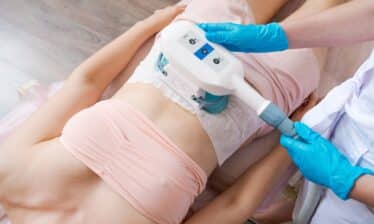Breast care is extremely personal. You might choose implants one day and change your mind down the road, deciding you’d rather have a smaller chest. Or, you might love your breast implants but find that your body has a different idea.
It’s all valid. Breast implants aren’t permanent, and surgeons remove them for many reasons. Whatever your motivations for removing breast implants, here’s what you need to know.
Benefits and Risks of Removing Breast Implants
Having a breast implant removal procedure is a personal decision. You and your doctor should discuss the pros and cons related to your situation. Here are some facts to start the discussion.
The Benefits
There are many reasons for breast implant removal. Some people choose it because their breasts have changed over time, often due to age or pregnancy. Others want a different breast size or shape, so they have a surgeon remove their original implant.
Implant removal can also be done for medical reasons.
Preventing Silicone Leaks
The American Society of Plastic Surgeons (ASPS) advises patients to have a surgeon replace or remove their implants every 10 to 15 years.1 If left in place too long, breast implants can break down and leak silicone into the breast. This isn’t always dangerous but can cause discomfort or changes to breast shape.2
Removing Scar Tissue
Scar tissue naturally develops around any surgical implant, including breast implants. It’s a way the body protects itself, and it helps keep the implant from slipping.
Sometimes, however, the scar tissue becomes unusually hard and starts to contract. This is called capsular contracture. In severe cases, it can change the breast’s appearance and even cause pain.3 Breast implant removal gets rid of the implant and lets the surgeon clear away scarring.
The Risks
The ASPS has identified particular mild to severe complications after breast implant removal.4 Some of these complications affect the look of the breast but aren’t medically dangerous. Examples include:
- Asymmetric results
- Scarring
- Skin discoloration
There are also certain medical risks such as:
- Complications from anesthesia
- Infection
- Bleeding and hematomas (blood pooling in the breast)
- Numbness around the surgical site
Talk to your surgeon about how removing breast implants might affect you.
What to Expect: Before, During, and After
Some people stay overnight in a hospital after breast implant removal. Others have outpatient procedures and go home the same day.5 Your surgeon will recommend the option they feel is best for you.
Preparing for Breast Implant Removal
Before your procedure, you may have to:
- Get a medical evaluation or lab testing
- Adjust your medication schedule
- Stop taking certain over-the-counter medications or supplements that can increase bleeding.
These steps increase the safety of surgery.
Steps of the Procedure
More than 48,000 people have breast implant removals every year.6 It’s a straightforward procedure suitable for people who:
- Are healthy overall
- Have a stable body weight
- Don’t smoke
Your surgeon will interview and examine you before the procedure to ensure you’re healthy enough for surgery.7
1. Anesthesia
Removing breast implants usually happens under general anesthesia. In some cases, your surgeon might decide that IV sedation is best. Sedation sends you into a deeply relaxed state without making you unconscious.8
Doctors use both types of anesthesia alongside local and regional painkillers so that you won’t feel anything during the procedure.
2. Incision and Implant Removal
Once the anesthesia is working, your surgeon will expose the implant by making an incision in your breast. There are two main incision types:
- A single cut along the lower fold of the breast
- An incision around or near the areola (nipple area)9
Your surgeon will then remove the implant. If you’re having the surgery to remove scar tissue, your surgeon will also remove the tissue capsule that has formed around the implant.10
There are many surgical techniques for removing breast implants. If you’re curious, ask your surgeon what strategies they use and why.
3. Closing the Incision
Your surgeon may close the incision with sutures, clips, surgical tape, or skin adhesives.11 Expect your breast to look flatter and/or more irregularly shaped than it did before surgery.
If you’re concerned about breast size or shape, talk to your surgeon before the procedure. You may be able to get a new implant as part of the same procedure or in a follow-up surgery.12
Breast Implant Removal Recovery
Immediately after implant surgery, you’ll have dressings and/or bandages over the wound.13 If you’re having an outpatient procedure and will be going home that day, ask your surgeon how to care for those dressings.
You may have drains in place to deal with fluid buildup. Drains are common in breast surgery and usually stay in place for a few days to several weeks.14 If you’re going home with a drain still in place, your surgeon will tell you how to care for it. Your surgeon might also ask you to wear a compression garment or support bra to help reduce swelling.
Recovery from removing breast implants usually takes several weeks. Your surgery plan and general health will determine when you can go back to work and start doing the things you did before the procedure. Ask your surgeon about the timeline that’s right for you.
Making the Most of Removing Breast Implants
Whether you’re having the procedure for aesthetic or medical reasons, removing breast implants can improve your quality of life. Boost your chances of success by following all of your surgeon’s instructions, including recommendations for follow-up appointments.
After surgery, be sure to take any medications prescribed to you. Medications can help with pain and prevent infection. Remember, your breast health matters. Implant removal can help.
SOURCES:
- American Society of Plastic Surgeons: ” What Is Breast Implant Removal Surgery?.”
- U.S. Food and Drug Administration: ” Risks and Complications of Breast Implants.”
- American Society of Plastic Surgeons: ” What is capsular contracture and how can it be treated?“
- American Society of Plastic Surgeons: ” What are the risks of breast implant removal?“
- American Society of Plastic Surgeons: ” How should I prepare for breast implant removal?“
- American Society of Plastic Surgeons: ” 2018 Plastic Surgery Statistics Report.”
- American Society of Plastic Surgeons: ” Who is a good candidate for breast implant removal?“
- American Society of Anesthesiologists: ” IV/Monitored Sedation.”
- American Society of Plastic Surgeons: ” What are the steps of a breast implant removal procedure?“
- Healthline: ” What You Need to Know About Breast Implant Capsulectomy.“
- American Society of Plastic Surgeons: ” What are the steps of a breast implant removal procedure?“
- Connect by American Society of Plastic Surgeons: ” New Breast Implants after implant removal.”
- American Society of Plastic Surgeons: ” What should I expect during my breast implant removal recovery?“
- Verywell Health: ” Surgical Drains After Breast Surgery.”





